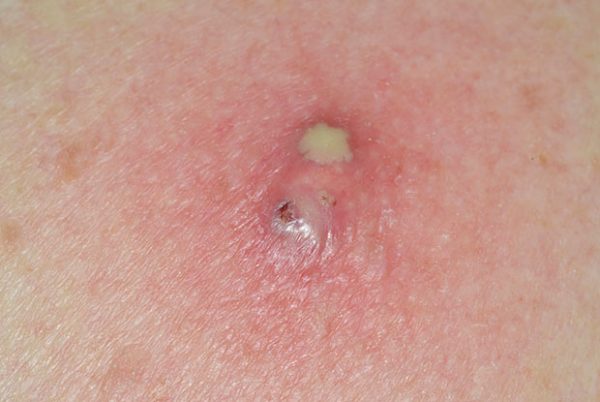Infected Sebaceous Cysts: Definition, Causes, and Symptoms
Infected Sebaceous Cyst Removal is a medical procedure used to remove sebaceous cysts that have become infected. It is a relatively simple procedure, but it does require the skill and expertise of an experienced medical professional.
What is an Infected Sebaceous Cyst?
A sebaceous cyst is a keratin-filled sac that typically forms just below the skin’s surface. Sebaceous cysts usually contain fatty material and may be filled with pus if they are infected. Infected sebaceous cysts are often painful and can be red, swollen or tender to the touch.
What Causes an Infected Sebaceous Cyst?
Infection of a sebaceous cyst typically occurs as a result of bacteria entering through a crack in the skin caused by trauma or other physical damage to the area. These bacteria then infect the content of the cyst causing pain, inflammation and other signs of infection such as redness, warmth and pus formation.
Symptoms of an Infected Sebaceous Cyst
The most common symptom of an infected sebaceous cyst is pain or tenderness in the affected area. Depending on the severity of infection other symptoms may arise such as swelling, redness, warmth over the affected area and pus formation at the site of infection.
The Basics of Infected Sebaceous Cyst Removal
Infected sebaceous cyst removal involves draining or surgically removing an infected sebaceous cyst. It is important to note that this type of procedure should only be done by a qualified medical professional who has experience in performing these types of procedures safely and effectively. Draining an infected sebaceous cyst can involve making a small incision on the top surface of the cyst so that any fluid or pus contained within can be drained out; this type of procedure is usually performed under local anesthesia so that any discomfort experienced will be minimal. Surgery for infected sebaciousy st removal involves removing both the contents and walls of the dermoid sac under general anesthesia; this process usually requires more time for recovery than draining alone but offers better results in terms of prevention from recurrence.
In both cases it is important to seek professional assistance for proper diagnosis before any form of treatment can take place as misdiagnosis can lead to further complications down the line if not treated correctly initially. Following surgical intervention it is also important to maintain proper aftercare instructions including proper wound care, antibiotics if prescribed by your doctor and follow up appointments with your doctor until full healing has taken place for best results when dealing with infected sebaciousy st removal . Regardless if you are opting for surgical or non-surgical treatment for your infectedse bacousey st it is always best to consult with your physician prior to making any decisions regarding treatment options; this will help ensure maximum safety during all procedures involved in treating your condition properly .
Treatment Options for Infected Sebaceous Cysts: Surgery, Medication, and Home Remedies
Infected Sebaceous Cyst Removal is a process of treating an infected sebaceous cyst that appears on the skin. This type of infection occurs when the sebaceous glands become blocked and develop into an abscess. The most common types of infected sebaceous cysts include epidermal cysts, pilar cysts, and steatocystoma. These cysts are usually harmless but can become painful if left untreated. When it comes to treating these infections, there are a few different options available.
Surgery
The treatment option for infected sebaceous cysts that is most often suggested by doctors is surgical removal. During the procedure, the area around the cyst will be numbed with anesthesia and then a small incision will be made to allow access to the infected tissue. The doctor will then use special tools to remove all of the infected material from inside the cyst along with some surrounding tissue in order to prevent further infection or regrowth of the cyst. After surgery, patients may experience some minor soreness or swelling at the site but this should go away over time.
Medication
Another treatment option for infected sebaceous cysts is medication. Antibiotics may be prescribed by a doctor if they believe that bacterial infection is present inside of the cyst. These medications can help to reduce inflammation and reduce any soreness or discomfort that may be present due to the infection. Additionally, topical antibiotics can also be applied directly to the affected area in order to help speed up healing.
Home Remedies
Finally, there are some home remedies that can be used in order to treat an infected sebaceous cyst. Applying warm compresses several times per day can help to reduce swelling and promote healing from within while also relieving any discomfort caused by the infection. Additionally, over-the-counter anti-inflammatory medications such as ibuprofen or acetaminophen may also help manage any pain or discomfort associated with this condition.
Infected Sebaceous Cyst Removal does not have a one size fits all approach as each person’s medical history and severity of their infection will determine which treatment plan will work best for them. It’s important for anyone who suspects they have an infected sebaceous cyst to consult with their doctor for diagnosis so that they can receive appropriate care.
Preparing for Infected Sebaceous Cyst Removal Surgery
When it comes to Infected Sebaceous Cyst Removal, preparation is key. Before going into surgery, there are some important steps to take to ensure the procedure goes as smoothly as possible. To help you understand the basics of this type of surgery, here’s a list of things to consider before scheduling your appointment.
What is an Infected Sebaceous Cyst?
An infected sebaceous cyst is a non-cancerous lump that develops beneath the skin due to a blocked sebaceous gland. Most commonly found on face, chest, or back, these cysts are typically painless but can become red and inflamed if left untreated. If left untreated, they can become infected and cause further pain and complications if not removed properly.
Consult With Your Doctor
Before considering infected sebaceous cyst removal surgery, it’s important to consult with your doctor or dermatologist first. During this consultation, they’ll be able to examine the cyst and determine whether or not it needs to be removed surgically. They will also go over any risks associated with this type of surgery so you have a better understanding of what’s involved before making your decision.
Making Preparations
If your doctor recommends that you have the cyst surgically removed, there are some preparations you should make before undergoing surgery. It’s important that you follow preoperative instructions from your doctor in order to ensure successful results. This may include stopping certain medications prior to the procedure or adjusting your diet leading up to it.
Your doctor may also advise you on other ways to prepare including finding someone who can drive you home after the procedure and setting aside time for recovery afterwards.
Recovering After Surgery
After infected sebaceous cyst removal surgery, your doctor will provide specific instructions for post-operative care such as keeping bandages on for a certain amount of time and using antibiotics if necessary. It’s important that you adhere to these instructions in order for the healing process to go smoothly without any complications.
Infected sebaceous cysts can cause discomfort and embarrassment when they become visible on skin surfaces. If you think you may need infected sebaceous cyst removal surgery, talk with your doctor first in order make sure you’re adequately prepared before undergoing any kind of procedure.
Post-Surgery Care and Recovery for Infected Sebaceous Cyst Removal
Having an infected sebaceous cyst removed can be a necessary part of maintaining your good health. After the surgery, it is important to take the proper precautions and follow the instructions provided by your doctor for post-surgery care and recovery. Here are some tips for recovering from an infected sebaceous cyst removal.
Take Time to Rest
After any type of surgery, your body needs time to heal. It is essential to get enough rest in order to recover properly and reduce the risk of infection or further complications. Make sure you allow yourself plenty of time off work or school if needed in order to rest and relax. Avoid strenuous physical activities such as lifting weights, running or exercising until you are given clearance from your doctor.
Manage Your Pain
Infected sebaceous cyst removal may involve cutting into the skin, so you will likely experience some pain after the surgery. Be sure to talk with your doctor about managing pain with medications such as ibuprofen or acetaminophen if needed. You may also want to apply ice packs to the area several times a day for 10-15 minutes at a time in order help reduce inflammation and discomfort.
Change Your Bandage Regularly
Your doctor may have placed a sterile bandage over the surgical site after removing the infected sebaceous cyst. Be sure to change this bandage on a regular basis as instructed by your doctor and avoid getting it wet in order maintain proper wound healing without irritation or infection.
Monitor Your Symptoms
It is important to be aware of any changes that occur with your infected sebaceous cyst following removal surgery. Keep an eye out for signs of infection including redness, swelling, fever, pus drainage, increased pain or itching around the surgical site that does not go away within a few days following treatment. Contact your doctor immediately if any of these symptoms occur so they can provide quick medical attention if necessary. Following these tips after having an infected sebaceous cyst removed can help ensure successful healing, reducing discomfort and minimizing infection risks so you can recover quickly and safely from this type of medical procedure.




